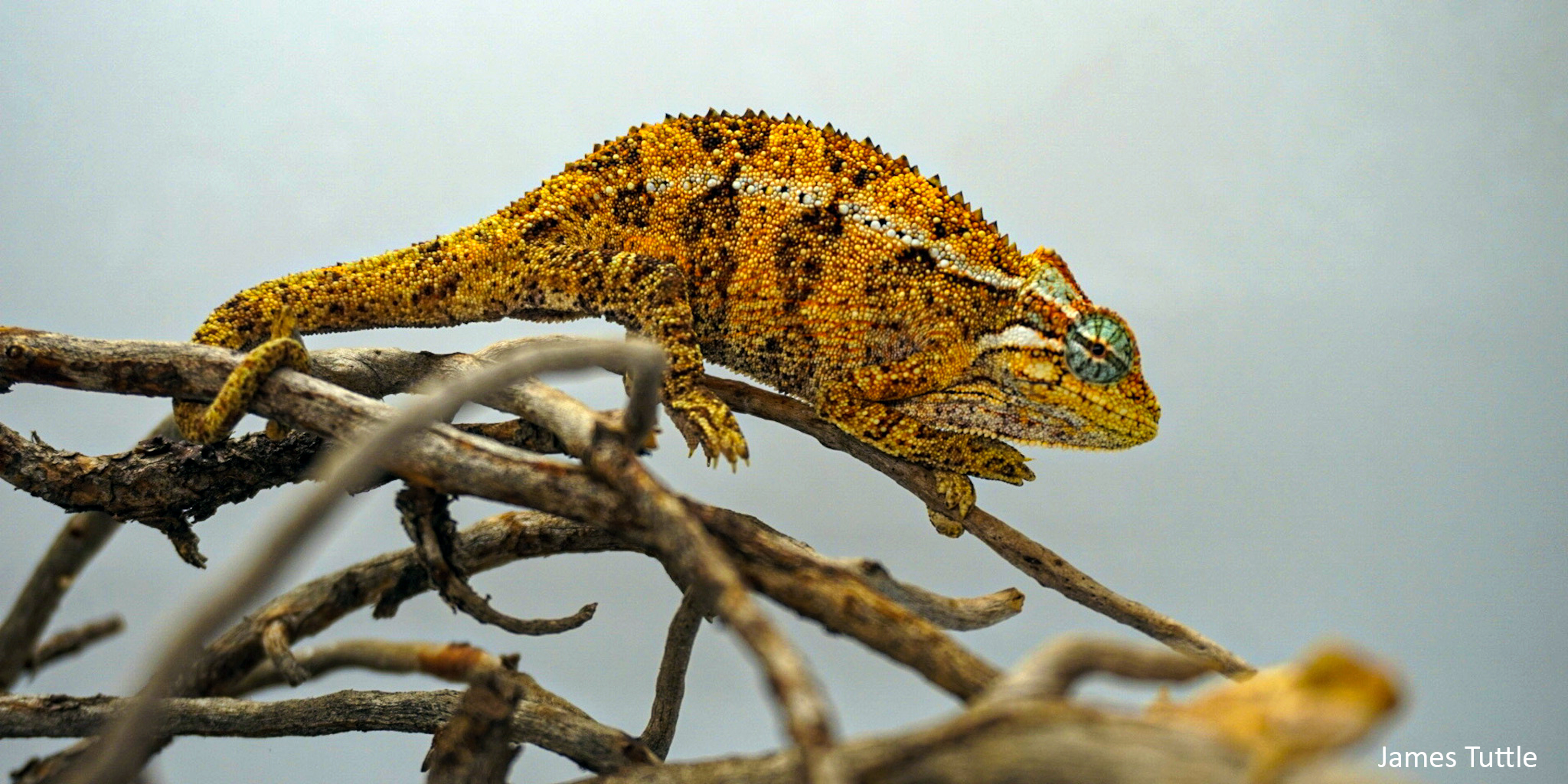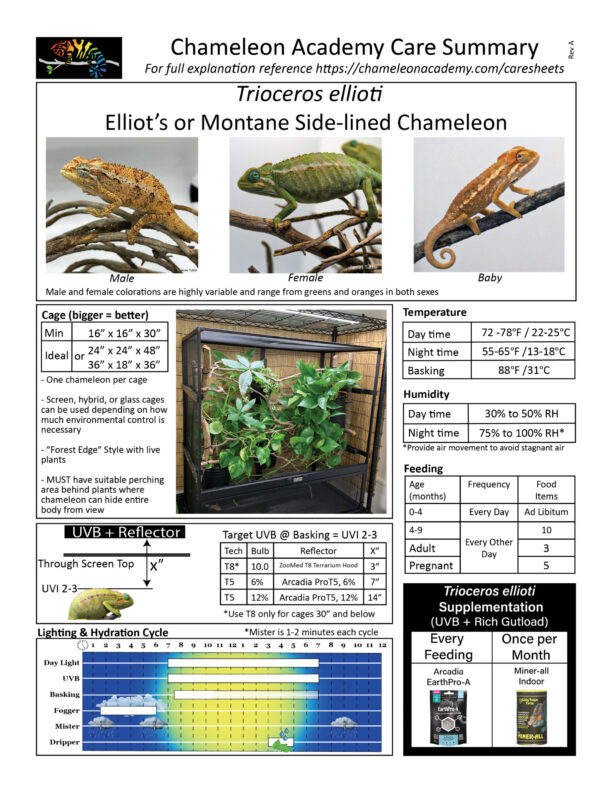Introduction to Trioceros ellioti
This small chameleon from Eastern Africa is a charming species where the males and females are equally desirable as far as color and shape. It is a livebearing species with the typical care requirements of montane chameleons. Ease of husbandry and hardiness of this species make it a prime candidate for establishing in captivity.
Trioceros ellioti Care Summary
I have multi-media resources available for Trioceros ellioti research. Included here is a short audio summary of Trioceros ellioti Care and a single page Care Summary sheet. You may click the audio player to hear the summary (you can also find it on the Chameleon Academy Podcast through your podcast app) and you may download the care summary .pdf below. Following this, just scroll further for a detailed care summary of Trioceros ellioti!
The Trioceros ellioti Care Summary distills the most important aspects of husbandry care into an easily referenced handout. But chameleon care is, unfortunately, much more involved than can be presented on a summary sheet. Therefore, you may use this sheet as a reference and return to this page where we will go over each and every aspect that is on the summary sheet in detail.
Natural History
Trioceros ellioti is a small, livebearing chameleon from Eastern African countries including Uganda, Tanzania, Kenya, Rwanda, Congo, Sudan, and Burundi. It inhabits elevations between 1200 and 1800m.
It has many common names such as Side-striped Chameleon, Groove-throated Chameleon, or Elliot’s Chameleon. But these common names are rarely used and when they are used it is inconsistent. Trioceros ellioti is one of those chameleons where the scientific name is the most well known.
The colors are highly variable with different colors between green, gray, brown, and orange coming from one mother.
Male

Female
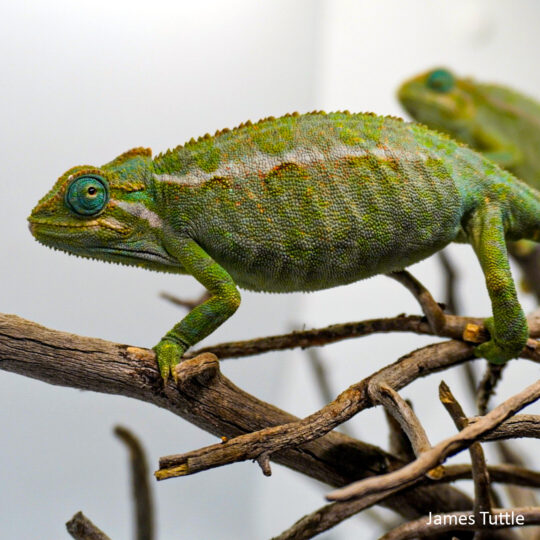
Baby

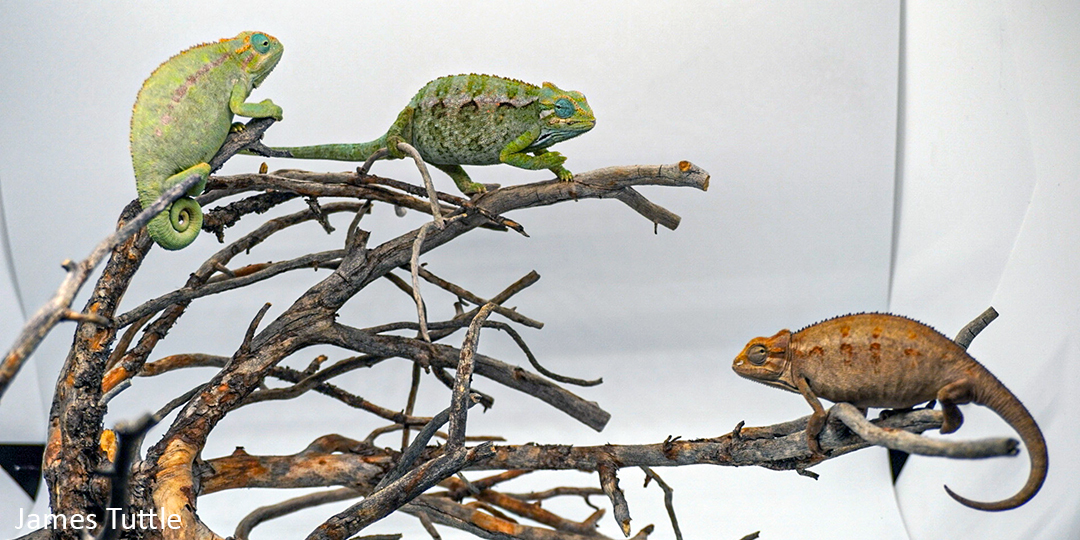
There is great variation in the Trioceros ellioti species. Across its wide range there are differences across locations and even within the locations there are variations. The above image shows the variation even within a group of females from Kenya. The Kenyan males have this same color variation across greens and oranges.
Personality
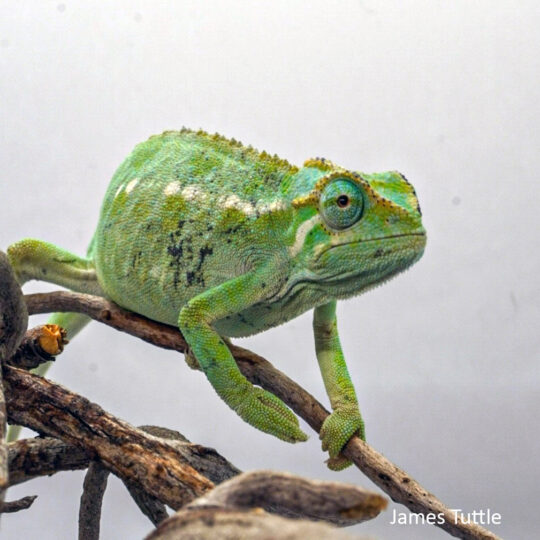
Trioceros ellioti has a mild personality. Though no chameleon should be considered a pet to be held and played with, this chameleon is not as high strung as some of its larger cousins. They are usually not aggressive towards each other, though there are reports of sudden violent responses in chameleon to chameleon interaction.
Like all chameleons, the ideal situation is one chameleon per cage. Though breeders can get away with keeping two females in a cage if they are raised together, be very careful not to let this lull you into a false sense of security. When this species acts out they act out in big ways that are potentially dangerous to cage mates.
Babies seem to be calm towards each other, but it is best to separate them as soon as possible. This species grows quickly and so they are not “babies” for long.
Purchasing Trioceros ellioti

Currently, Trioceros ellioti is available as both wild caught and as captive born. Captive born is ALWAYS the best bet and worth the extra money. These babies are raised with the best nutrition and are raised among humans and cages so they are acclimated to captive conditions. If you are familiar with acclimating wild caught chameleons and are wanting to breed them to introduce a new bloodline then you know what you are getting into with buying wild caught animals. But if you are wanting to get one of these chameleons for the pleasure of keeping then bypass the acclimation challenge and get captive born.
With this species males and females vary in color and both make excellent pet chameleons (as “pet” as a chameleon gets, of course!). Trioceros ellioti is one of those rare chameleons where males and females have equal rating in both color and personality.
If you do purchase a wild caught female or any female that has been kept with males once she is 4-6 months old you are likely to have a female which will give birth to live babies. The timing of this is unknown and you may get a surprise one morning of babies crawling around the cage. The females will store sperm and produce multiple groups of babies from one mating so being away from a male for a year does not save you from this! It is a very good idea to be ready for babies unless you are sure you have a captive born females that has never been in a cage with a male. after 3 to 4 months of age.
Cage Type and Size

Cage Size: Trioceros ellioti is a small chameleon with little need for movement. Therefore, they can be housed in small cages. The absolute minimum cage size for one specimen is 16″ x 16″ x 20″. But this is for experienced keepers and breeders who know how to create the necessary cage conditions in small spaces. If you are getting a chameleon for the enjoyment of the chameleon then do not settle for the minimum. The easily obtained 18″ x 18″ x 36″ size cage gives a bit more room. But if you want to maximize your enjoyment and your chameleons’ comfort, get a 24″ x 24″ x 48″ or 36″ x 18″ x 36″ cage. Your small chameleon will do excellent in that amount of space.
Consider it from this perspective. When you get the minimum size cage you place branches, plants, and lights highly strategically because you have only one chance to create the minimum gradients and microclimates necessary for healthy chameleon life. When you get a cage that gives you extra room you start to look at the cage artistically. You place plants and branches where they look the best. Of course, you have the chameleon’s needs in mind when you do this, but you now have the luxury to meet these needs with an artistic approach that is pleasing to the human eye. This can creates a slice of nature that is much more enjoyable, calming, and beautiful than is possible with the minimum cage condition. Please reference the page on the Forest Edge approach to chameleon cage building for a guide to making a beautiful chameleon cage.
And finally, with a small amount of space you are responsible for creating the right temperature gradients with light bulbs that are designed for bigger cages. This means it is very easy to provide more heat or UVB than is healthy simply because it the small space was energized quickly and there is physically less space to escape the heat or UVB.
Cage Type: You may use screen cges, hybrid cages, or glass cages. The cage should be chosen based on how much help you need to achieve the environmental goals for temperature and humidity.
Ambient Temperature
Elliot’s Chameleons thrive in the typical montane environment which is in the low to mid 70s as an ambient daytime temperature with a nighttime drop to the low 60s or, better yet, in the 50s F. They will not get quality sleep at higher nighttime temperatures. They may appear to be surviving just fine, but this lack of quality sleep will eventually catch up to them. It will be a constant, and cumulative, physical stress on the body and result in a compromised immune system. This allows opportunistic infectious agents to take hold.
Breeder Michael Nash has observed that his specimens gravitate towards a basking spot of around 88F which is strangely higher than other montanes seem to prefer.
Basking Temperature
A low nighttime temperature is a requirement for a healthy Trioceros ellioti. But your chameleon will need to warm up in the morning to get a good start on the day. In the wild, chameleons look to the sun rise and bask until their body temperature is sufficient for optimal hunting, digestion, and general function.
In captivity we give them this warm up through a basking bulb which is usually an incandescent or halogen bulb shining on their basking branch.
We need to be careful when setting up this bulb as it is very easy to burn your chameleon. Chameleons do not seem to have a keen sense of when they are being burned. They know when they need to warm up, but have not developed a mechanism to measure the concept of “too hot”. There is nothing in nature that would drive the development of this ability. So chameleons will over heat themselves or even burn themselves. We need to be extra careful to protect them from this opportunity. This is the reason that we will be encouraging basking bulbs to be mounted above the cage instead of on the cage top. The closer to the bulb, the more difference in temperature can happen in an inch. The ideal scenario is to have a higher wattage bulb further away. This produces a wider, and “gentler” heated area that has no burn risk.
For basking temperature, Breeder Michael Nash has noted that his T. ellioti seem to like the basking temperature in the 88F range. This is a little higher than other familiar montane chameleons, but still well within the reasonable limits. But the exact temperature is not that important. It is more important to set it up so you feel a warm and gentle heat on the back of your hand when you place it where the top of the head of your chameleon would be when he is basking. Your main purpose is to set up a safe temperature to start with and then you will adjust the bulb distance based on your chameleon’s behavior. If your chameleon shows the following behaviors, you can consider either providing a basking temperature for longer time or else, cautiously, a higher basking temperature.
- Hanging from the top screen panel under the bulb
- Remaining dark and lethargic. After basking, they should take on resting colors.
The issue with relying on behaviors as a signal to move the bulb further away is that they generally are physical damage to the body such as gray burned areas, open wounds, and melted back spines. And it is concerning how long this kind of situation goes on before the keeper realizes what is going on. So this means the chameleon is basking even though it is too hot. Also note that when reading your chameleon’s behavior that each chameleon will be slightly different. Get to know your chameleon’s behaviors so you can verify that they are following standard chameleon behaviors.
Humidity
Elliot’s Chameleons experience high humidity nights and mid to low humidity days. A nighttime humidity of 75% to 100% and then a drop to 30-50% during the day will allow them to engage in their natural humidity cycle. The exact numbers are not critical. There are two important aspects. 1) during high humidity times keep the air moving. Often cages are modified to enclose sides to impede airflow so a fogger can increase humidity. In this case have a ceiling fan or computer fan mounted to the top of the cage make sure that the “fog bank” circulates. Stagnant air, regardless of how humid, is unhealthy. 2) All surfaces must be dry during the day. Even if humidity is higher than the numbers listed, if the surfaces are dry then there shouldn’t be a health problem. It is when surfaces, such as the branches the chameleon climbs on are constantly wet the feet get sores and bacteria/fungus/mold is able to take a hold.
Lighting
Trioceros ellioti take the standard bright light that we put on our chameleon cages. A quad High Output T5 fixture the width of your cage with four 6500K fluorescent bulbs will light a 4’ tall cage nicely. A 12 hours on and 12 hours off cycle is used. Kenya is close to the equator and so this 12 on/12 off does not have to change through out the year.
Your chameleon will need it bright inside his cage. The biggest cage deficiency, behind no hiding place, is insufficient light where, when you look at the cage, the chameleon looks like it is in a cave with a skylight. A bright cage will allow plants to grow and your environment to be vibrant.
Natural sunlight through a window is excellent, but dangerous. Sunlight tends to be too powerful and could overheat your chameleon. Be careful with sunlight. Definitely give your chameleons natural sunlight whenever possible, but the sun can cook your chameleon quickly, especially a small one like T. ellioti. Heavily planted outdoor cages and constant supervision are recipes for success.
UVB
Outside of unfiltered natural sunlight, the most effective and reliable way to producing UVB for your chameleon is with linear T5 high output fluorescent tubes. These bulbs may go into a multi-bulb fixture, but are most effective in a single bulb reflector. I highly recommend using a single bulb reflector for your UVB source as it gives you not only the full power of the bulb (your UVB gets soaked up by other bulbs), but it gives you full control over the UVB strength that hits the basking area depending on how high you raise the fixture above the cage.
Presently we are targeting an UV Index of 2-3 at the basking branch with a maximum of UVI 6 to allow for sufficient vitamin D3 synthesis. This is generally what you can generate using a T5 HO Arcadia ProT5 fixture with 6% UVB or Zoomed Reptisun 5.0 in a single bulb reflector at a basking branch 6″ inches from the light going through a standard screen cage top panel. These numbers are all general estimates as each reflector will have its own reflection properties and each bulb will have different strength depending on age. Luckily, this does not have to be an exact value. Ballpark is fine! If you are using a Reptisun T8 10.0 in a single bulb fixture then the basking branch should be 3″ below the bulb going through a cage screen top. Ideally, no matter which bulb you use, you are able to lift it up off the cage top surface. UVB bulbs produce very high UVB at the first couple inches in front of the light bulb. You can still use the given distances from the bulb with the bulbs raised two to three inches above the cage top. This reduces the maximum level of UVB that gets into the cage and your chameleon is exposed to. Although we have not been able to measure what damage is being done at what UVB levels, it is safe to expect that there would be a point where the high UVB from the lamp could cause problems. They may not be human, but chameleons have living cells, and living cells are damaged by UVB.
Just a note, UVB Meters are an expensive piece of equipment, but are a valuable tool in setting up your chameleon’s environment. If you can get one – do it! Get the Solarmeter 6.5 model.
Setting up the lighting and hydration schedule
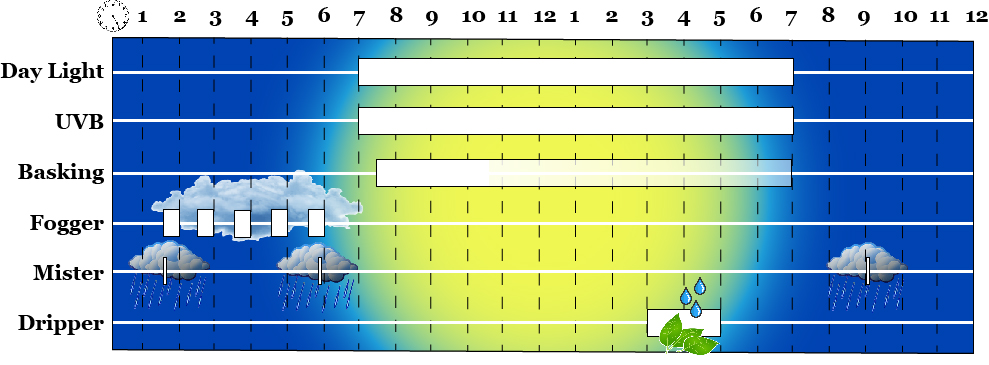
When we set up our daily schedule we are attempting to replicate the wild conditions that the chameleon has grown to expect. Let’s start at midnight.
At midnight the chameleon has been asleep for many hours. It is dark and, although the moon waxes and wanes, chameleons will seek out dark places to sleep. They see light of all colors just fine and any light can disturb their rest.
As the early morning progresses the humidity rises. Fog banks can start to form and the chameleon is breathing in moist air. This high humidity forms an important part in their natural hydration. To simulate this, we turn ultrasonic humidifiers on around 1:30AM. The fog from the humidifiers tends to bounce off of surfaces and roll out the cage so we run the misting system for a couple of minute to coat the cage in a layer of water. This helps the fogger be more effective and the fog tends to stick around. The fogger go from 1:30 to 6:00 in a 30 minutes on and 30 minutes off pattern. This is to protect against too much fog. This is wise when you have closed in three or more sides of your cage to retain humidity. If you have a completely screen cage then you may leave it on the entire time. This all is done so the chameleon can breathe in the humidity. Just before the lights come on the misters are run for another couple of minute to make sure that when the chameleon wakes up it wakes up to surfaces covered in “dew”. This is a natural source of water for them even in their dry season. Once the dew is laid down the lights can come on.
Around 7AM the daylights come on. This can include the UVB light if they are the same fixture. If they are separate fixtures then save turning the UVB light on to correspond to when the basking bulb is switched on. I like to leave the daylight bulbs on for 15 or 30 minutes to give the chameleon a chance to leisurely lick whatever dew they want. I then turn the basking bulb on so they can warm themselves up.
As the ambient temperatures start to warm there is no longer the need for a basking lamp and it is shut off. The actual time that the basking lamp is on will depend on your chameleon’s needs. Watch the behavior. If the routinely get the warmth they need in 30 minutes and then climb away with content colors to hunt then reduce your basking time to that time that they make use of the warmth. If they need the warmth for a longer period of time then leave the basking bulb on longer or consider increasing the temperature slightly. Watch your chameleon and they will tell you what they need. With a screen cage there is usually no issue leaving it on for the day, but if your ambient daytime temperatures start getting to the high end of their comfort, you can shut the basking lamp off.
Sometime during the day (I start at 3PM) start your dripper. This is a backup hydration strategy just to make sure they have enough water. While it is true they do not have drippers every day in the wild during the dry season, they also are not needing to reconstitute dry calcium powder on all their feeders. The advantage of running a dripper is that it is completely optional for them and, as a bonus, it also allows you the opportunity to ensure your plants get watered. Place it above a different plant each day and through out the week, all plants will get watered. It is not critical when you start the dripper. In this schedule I have it in the late afternoon so that the chameleon can rehydrate before the evening rest. I suggest starting the dripper an hour or so after feeding them so they can replenish what they need. In the wild, their food is a major source of hydration. We mess that up a bit with our powders and a dripper is a way we make up for that. Ideally, the chameleon will have gotten enough hydration from the moist night air, morning dew, and food items. I consider it a success when the chameleon ignores the dripper and an early warning sign when he drinks from the dripper.
Once the chameleon settles in and goes to sleep I like to have a couple minutes misting just to set up the night humidity.
You’ll notice there are no daytime mistings. Although this is common in chameleon husbandry, and I did it myself, I have transitioned my mistings to the sleep hours. Chameleons have been consistent in their communicating that they do not like being sprayed. I have given up deciding I know what is best for them and started to listen to them. The night fog, morning dew and the afternoon dripper provide the necessary hydration in a natural way. With those provided there just isn’t a need to force them into a shower in the middle of the day.
Feeding & Supplementation
Feeding Trioceros ellioti
T. ellioti is not a picky eater. It will eat the standard chameleon feeder insects of appropriate size. Flying insects are relished. One interesting characteristic is that they seem to prefer smaller than normal food. Generally, when we determine the proper feeder size for a chameleon we pick a size the length equivalent to the width between the eyes. And then the chameleon will often surprise us and wolf down something bigger. T. ellioti, on the other hand, seem to prefer food smaller than we would normally feed. It is important to pay attention to the sizes of food items your individual chameleon prefers. They are the expert. Try different sizes and your chameleon will quickly let you know what they prefer. But do not be worried if your adult goes after a fruit fly. This is a characteristic of the species.
T. ellioti is insectivorous. You can feed them anything that moves and fits in their mouth. There is no need to provide fruits or vegetables for this species.
As with caring for any of our chameleon species, we want the insects we feed to be as nutritious as possible. Unfortunately, our knowledge of insect to chameleon nutrition is in its infancy so we do not know what the wild insect diet gives to chameleons or, even what nutrients in what we fed our feeders gives to chameleons. There are reports that insects exposed to UVB produce vitamin D3. So, do chameleons actually get some dietary D3 in the wild? There is much speculation and little firm. Therefore, we feed as wide of a feeder variety as possible and we feed these insects as wide of a range of fruits, vegetables, grains, etc…as we can find. It is presumed that a healthy, well-fed cricket is nutritionally superior to one that has had little to eat. Check out the page on nutrition for more information.
We also dust the feeders in mineral/vitamin powder to provide for the chameleon’s calcium. We call this supplementation.
Supplementation is one of the least defined aspects of chameleon husbandry. We literally do not know what they need. We are guessing. The best we can do is try to get as close to their natural processes as possible and test regimens out.
There will be a number of approaches that work. The bottom line test is whether it produces a healthy, long lived chameleon. If it does then it is valid!
Trioceros ellioti is presumed to have the typical “montane” sensitivity to over-supplementation. Though we are not seeing cases of edema becoming known. Thus, .
Supplementation
Currently, we see that T. ellioti does well when supplemented regularly with calcium and bee pollen. A monthly vitamin supplementation has been included, though we are currently testing the pros and cons of including performed vitamin A in this monthly dose. Minerall-I is being recommended as it has been tested, but Arcadia RevitaliseD3 is being evaluated for its equivalent levels of D3 and addition of small amounts of vitamin A. We are depending on UVB for our D3.
Prerequisites
The Chameleon Academy supplementation schedule relies on 1) the presence of UVB in the strength of at least UV Index 2-3 for D3 conversion and 2) a rich gutload of feeder insects.
The Pre-Requisite of UVB levels at UV Index 2-3
The Chameleon Academy Supplementation Routine relies heavily on the chameleon producing its own Vitamin D3 from UVB exposure. This uses the natural body mechanisms designed for this purpose. This is highly desirable as vitamin D3 is fat soluble and can be overdosed and can cause serious health issues. Going through the natural process has a natural cut off where the body will stop producing D3 when it has enough. It maintains optimal levels in a way that we have no possible way of replicating. With sufficient UVB, dietary D3 may be removed from the regimen. At this point, T. ellioti have been observed preferring levels of UVI 2-3 and have successfully reproduced under these conditions.
The Pre-Requisite of Gutloaded Feeders
In all instances, feeders should be richly gutloaded with a variety of fruits and grains. They must be cared for with proper heat and even, we are learning, exposure to UVB. This creates the most healthy, nutrition packed feeder for your chameleon. Supplements are just that – a supplement to a properly gutloaded, healthy feeder insect. Supplements will not make up for a poorly fed feeder insect. Every supplementation routine requires a properly gutloaded feeder insect.

A nutrition regimen consisting of Arcadia Earthpro-A, Minerall-Indoor, a UV Index of 2-3, and richly gutloaded feeder insects will provide nutrition for an Elliot’s Chameleon over each of its life stages.

Supplementation is just one component of the nutrition strategy. You must also have both a proper UV Index and feeder insects that are richly gutloaded for the Chameleon Academy supplementation regimen to work properly.

The Arcadia EarthPro-A supplement was chosen as the every-feeding supplement because, in addition to calcium and basic B vitamins, it has bee pollen and carotenoids as major components. Bee pollen is a natural superfood while these carotenoids are the best chance we have of cracking the mystery of the vitamin A cycle in chameleons.

In this species, Minerall-I is presented as the once-a-month vitamin supplement as this is what the founding breeder of T. ellioti in the US was using. We are testing out the more up to date supplements to be able to confidently upgrade the supplementation routines. Minerall-I has a low level of D3 and no preformed vitamin A. Currently, we are testing with Arcadias RevitaliseD3 as the monthly vitamin supplement and will update this section when we have verified its effectiveness.
Breeding Trioceros ellioti
Elliot’s Chameleons are live bearing species and, since the mother incubates the eggs, are quite simple to breed. In fact, if your mature female has ever had contact with a male in the last two years you may get babies whether you want them or not.
As exciting as this sounds, having chameleon babies can be heartbreaking if you are not prepared. If you have a female that had any chance of having contact with a male then at least read up on chameleon baby care.
The actual breeding process is standard. The female is moved to the male’s cage. If she is receptive she will allow him to mount her. If she is not receptive she will gape, sway threateningly, and show mottled colors. Breeder Michael Nash reports a female grabbing a male giving unwanted advances with her mouth and tossing him away. Monitoring the situation is highly recommended.
Gestation is a short three to four months and then up to 22 babies can be born depending on the female’s size.
Female introduced to Male
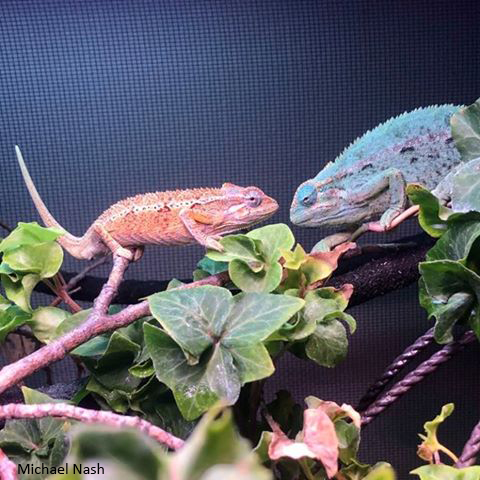
Mating

Gravid Female

Baby

Baby
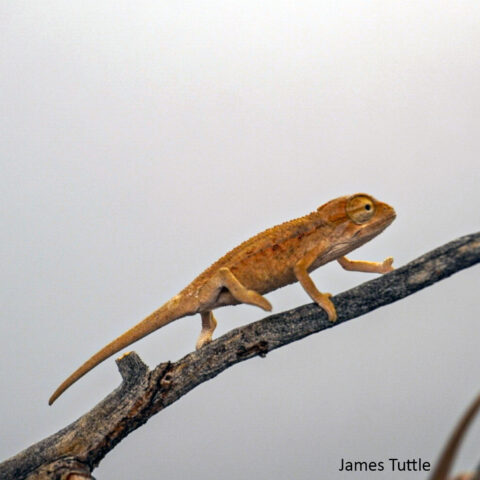
Baby



